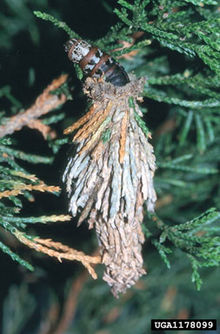Evergreen bagworm
| Evergreen bagworm | |
|---|---|
 |
|
 |
|
| Scientific classification | |
| Kingdom: | Animalia |
| Phylum: | Arthropoda |
| Class: | Insecta |
| Order: | Lepidoptera |
| Family: | Psychidae |
| Genus: | Thyridopteryx |
| Species: | T. ephemeraeformis |
| Binomial name | |
|
Thyridopteryx ephemeraeformis (Haworth, 1803) |
|
The evergreen bagworm (Thyridopteryx ephemeraeformis), commonly known as bagworm, eastern bagworm, common bagworm, common basket worm, or North American bagworm, is a moth that spins its cocoon in its larval life, decorating it with bits of plant material from the trees on which it feeds.
The evergreen bagworm's case grows to a length of over 6 cm, tapered and open on both ends. Newborn larva are blackish and turn brown to tan as they grow, mottled with black. The heads and thorax develop a yellow tint as they grow to a full length of 24 to 32 mm. Adult males resemble bees, having a 25 mm wingspan with transparent wings (thuris window + pterux wing) and black furry bodies. Adult females are maggot-like with yellowish-white soft bodies 19 to 23 mm long and small tufts of hair near the end of the abdomen. The cream-colored eggs are 0.75 mm in diameter.
The evergreen bagworm thrives in the eastern United States as far west as Nebraska, north into New England and bordering the Gulf of Mexico south throughout Texas. It has been found in other countries, such as South Africa, Croatia, and in the north-east of Iran. Large populations in forested areas are rare. With scarce predators in urban areas, evergreen bagworms often thrive in urban habitats. When disturbed, the larva will retract its head into its case and hold the front opening closed. Mature larva may remain in the host tree or drag its case nearby before attaching itself for the pupa stage.
Arborvitae and red cedar are the favored host trees of the evergreen bagworm, but cypress, juniper, pine, spruce, apple, birch, black locust, elm, maple, poplar, oak, sycamore, willow, and over 100 other species are also attacked. Leaves and buds are both fair game for food.
...
Wikipedia
